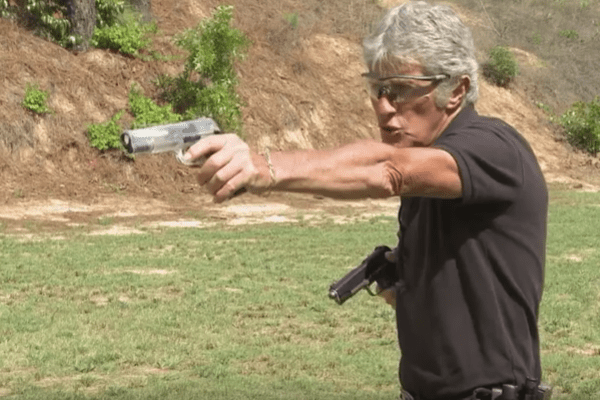The line has been drilled into everyone who carries a firearm and otherwise prepares for violence coming from the Earth’s dominant apex predator species: “Two is one and one is none.”
When people invoke this axiom in the firearms world, they’re most often talking about the number of magazines that a member of the armed citizenry takes with them when venturing out beyond the wire.
Magazines are, after all, the Achilles’ heel of the modern semiautomatic pistol. Despite the lack of hard numbers on this, it seems reasonable to say that magazines are more likely to be shoved blindly into overstuffed drawers, ejected with a full complement of cartridges onto the dirt at the range, and generally subjected to abuse as if they were head bolts on a 1981 Oldsmobile diesel engine.
They’re also the parts with the thinnest metal or plastic, more likely to be damaged than a part on the firearm itself. This author had such an issue with one of the magazines that shipped with his freshly-made GLOCK 43 in 2015. Heck, Larry Vickers still thinks that most new 1911 magazines should be ditched unless they come from a source with decades of proven reliability.
Still, even if no mechanical issues occur after the balloon goes up, having extra rounds on standby is a good idea, no matter how you look at it. Writers here have hammered home these points repeatedly.
This author learned his lawyerin’ from Fightin’ Illini who knew how to dissect an argument, and this one seems solid. Magazines are the weakest link in the semi-automatic chain. And since you can’t have too much ammunition, throw an extra mag or two in your pocket before venturing out. Logical.
But there’s a premise buried in there that doesn’t hold water for the average civilian who carries a firearm for self-defense purposes. That is . . .
During a surprise violent attack, where the combatant must fight immediately or suffer either death or grievous bodily injury, when the gun suffers a malfunction, she will be able to identify and cure the problem with a fast clearance drill, reload, and resume fighting in time to ensure a successful outcome.
Is that really going to happen?
The late firearms trainer/philosopher Louis Awerbuck sure didn’t think so. In his 1999 book, Tactical Reality (at 151-52), he says:
[I]t will take approximately half a second before it sinks into your brain that you have a mechanical malfunction or have run out of ammo. Bearing in mind that your assailant has already closed distance by six feet in this half-second…and you have not physically even begun to fix the mechanical problem, it is obvious that at contact distances you don’t have a snowball’s hope in hell of neutralizing your incoming attacker with that firearm….
Practice to perfection reloads and malfunction drills, but don’t delude yourself that it can be accomplished for real without distance, cover, or concealment as an ally. At contact distances it cannot be done. Period. This is tantamount to attempting a 200-yard rifle shot at a springbok running at full tilt (and bounding six feet into the air) while he’s at full bore). The word lunacy comes to mind.
If your only option is to do a malfunction drill when a determined enemy’s within three yards…English fails me. ¡Ay! ¡Qué fucked!
At the same time, each fight is unique. Circumstances may permit a tactical withdrawal to cover and enough time to do a reload. Albeit rare, it has happened, even to non-military, non-LEO types.
But if one wants to cover the risk, then it makes a lot more sense to carry the backup magazine, pre-loaded, in a back-up gun.
For those already on board with the idea of carrying one or two extra mags, the idea shouldn’t seem that radical. People carrying a concealed firearm for personal self-defense have already found space for a blaster on one hip. Concealing a gun on the opposite hip doesn’t require that much more effort.
And if one wanted to go for a .380 — say an LCP or one of those “I can’t believe it’s not a Colt Mustang” clones that everyone makes nowadays — or a J-frame size revolver, well, those things fit in the average man’s pants pocket almost as easily as a double stack magazine.
Which is better when seconds count? Seventeen rounds that go downrange after the gunfighter successfully performs a double-feed clearance drill while under fire, or six rounds that are ready to fly as soon as leather (or pocket) is cleared?
The point isn’t to denounce the idea of carrying an extra magazine. Context is king. Certainly, those in the military or civilian law enforcement might want to carry some extra mags in addition to a backup gun, given their higher likelihood to engage in a prolonged fight, and limited ability to choose the time and place of those fights.
As Mr. Awerbuck says, the wise gunhandler will train for a variety of situations and keep such tactical tools handy in their mental toolbox. And train. Train to pull a backup pistol — and shoot — with your weak hand as much as you can.
It’s just that time, money, and belt space are usually at a premium and must be prioritized. You can’t carry everything. Every piece of EDC gear needs to be carefully scrutinized, periodically reconsidered, and dispassionately left at home if something else can do the job better.
If a reload or malfunction clearance is needed in the middle of a fight, it’s needed now. Not in two minutes, not in five seconds, not after the old magazine is ripped out of the well, now.
For those who wish to carry insurance against that eventuality, finding a little extra space for a second gun is ultimately more efficient than carrying a spare double-stack magazine that, in all likelihood, will be no more effective in the moment of decision than a talisman.
[This article was originally published in July of 2017.]
